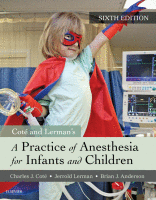Physical Address
304 North Cardinal St.
Dorchester Center, MA 02124

THE PREMATURE INFANT IS DEFINED as birth before 37 weeks gestation. Premature births can be classified as low-birth-weight (LBW) infants (<2500 g), very low-birth-weight (VLBW) infants (<1500 g), and extremely low-birth-weight (ELBW) infants (<1000 g). Alternatively, they may be classified as moderate to…

MILLIONS OF PEOPLE ARE TREATED FOR BURNS every year in the United States: hundreds of thousands of those who are hospitalized have a significant mortality rate. The National Burn Repository Report for 2014 reviewed its 10-year experience (2003–2013) ; overall…

pediatric plastic surgery is performed in children of all ages, even in utero. However, the majority of children who undergo plastic surgical and reconstructive procedures are between 2 and 9 years of age, with a median age of 5 years.…

THE INFANT OR CHILD who presents for elective ophthalmic surgery requires careful preanesthesia assessment. In addition to ophthalmologic issues, the infant or child may have associated or unassociated systemic disorders. In this chapter, we review the essential issues that should…

Otorhinolaryngologic Procedures Represent a large segment of elective surgery in infants and children. Anesthetic management is provided by both pediatric and general anesthesiologists, commonly in ambulatory surgery centers and office practices. Additionally, anesthesiologists are often consulted to help manage potentially…

ANESTHESIA FOR ORTHOPEDIC AND SPINAL SURGERY provides a multitude of challenges. Children often present with concomitant diseases that affect cardiovascular and respiratory function. The ability to maintain a clear airway during anesthesia is not straightforward for some children, such as…

Liver Transplantation The first successful pediatric liver transplant was performed by Tom Starzl and colleagues in 1967, but the history of liver transplantation actually began in 1955 with Stuart Welch in Albany and Jack Cannon at UCLA. Welch was the…

Anatomy THE LIVER AND BILIARY TREE are derived from the endoderm of the dorsal foregut during the late third to the early fourth week of gestation. By the sixth week, the fetal liver primarily serves as a hematopoietic organ, while…

ABDOMINAL SURGERY AND UROLOGIC interventions make up a large fraction of anesthetic practice for the pediatric anesthesiologist. The field is rapidly evolving, with increased use of laparoscopic surgery, including robot-assisted procedures. This chapter focuses on the specific issues related to…

THE ANESTHESIA PRACTITIONER IS OFTEN FACED with a child who has acute kidney injury (AKI) or renal failure. Renal disease requires the practitioner to be vigilant about fluid homeostasis, acid-base balance, electrolyte management, choice of anesthetics, and potential complications. This…